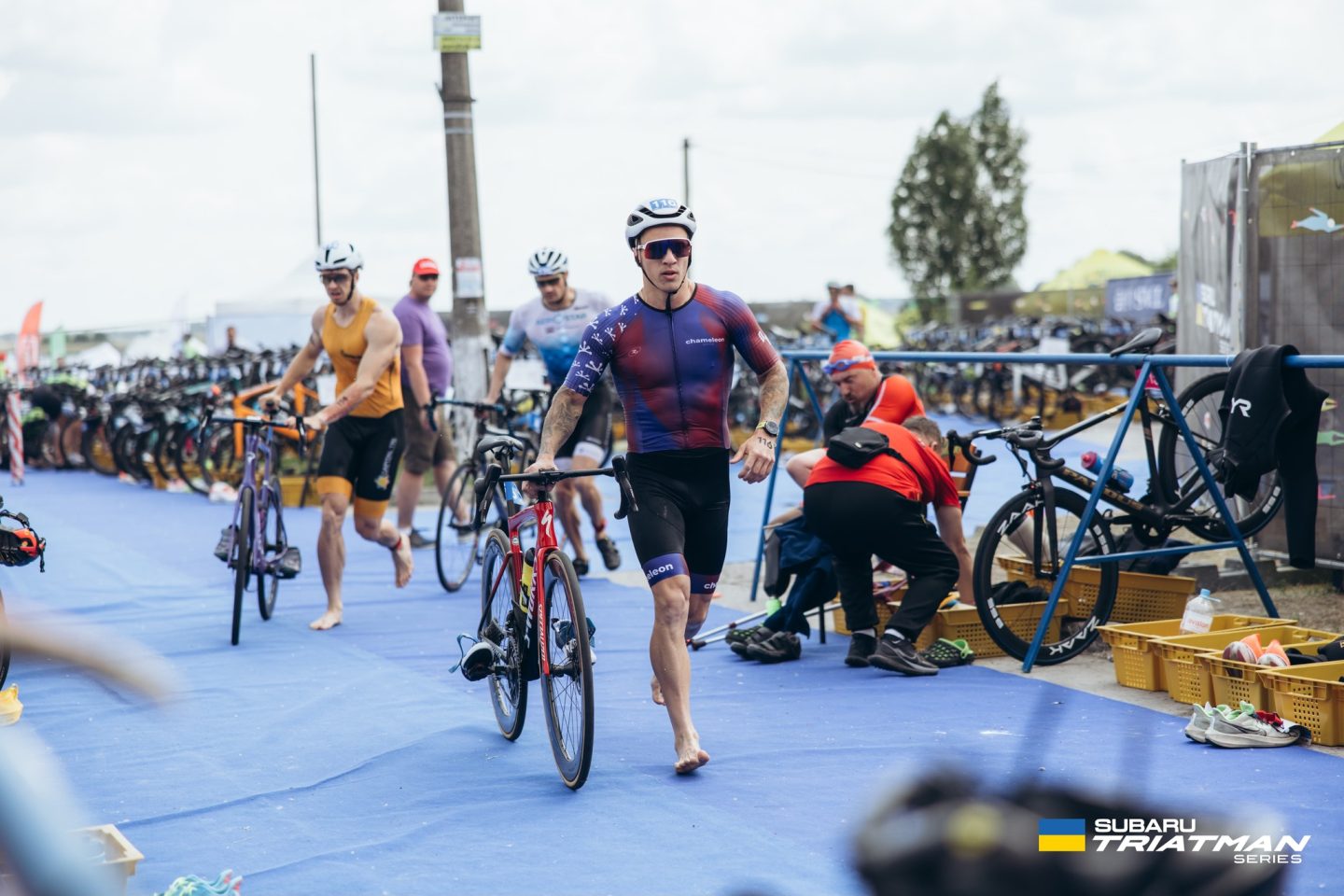Triathlons are a test of endurance, resilience, and technique.
However, there’s a hidden pillar that many tend to overlook: the vital role of strength and conditioning.
It’s not merely about swimming, cycling, and running longer and faster.
It’s also about doing so with strength, ensuring peak performance, and minimizing injury risks.
In this article, we will explore the importance of incorporating strength training into your triathlon workout routine.
The Benefits of a Triathlon Strength Training Plan
As the legendary triathlete Mark Allen once said, “Strength training is the key component that ties together the three disciplines in triathlon.”
Triathlon strength training sessions offer numerous benefits that can enhance performance across all three disciplines – swimming, cycling, and running. Let’s delve into some of these benefits.
Enhanced Performance in Each Discipline
Strength and conditioning don’t just make you stronger; they make you more efficient.
Swimming
With a stronger upper body and core, each stroke becomes more forceful.
This means more propulsion through the water with each movement, leading to faster swim times.
Additionally, improved muscular endurance allows swimmers to maintain proper technique for longer distances without fatiguing as quickly.
Cycling
Stronger leg muscles, particularly the quadriceps, glutes, and hamstrings, generate more power with each pedal stroke.
This translates to increased speed and efficiency, especially when climbing hills or accelerating out of corners.
Additionally, a strong core helps maintain stability on the bike, improving handling and reducing energy wasted on unnecessary movements.
Running
A more robust stride results from stronger leg muscles and improved biomechanics.
This means greater propulsion with each step and reduced ground contact time, leading to faster running times.
A strong core and stable upper body also contribute to better posture and breathing efficiency, allowing runners to maintain speed and endurance over longer distances.
The study published in the Journal of Strength and Conditioning Research provides empirical evidence of the benefits of strength training for triathletes.
It found that after a specific period of endurance training, triathletes improved their race times by an impressive 3%.
This significant improvement underscores the impact that targeted strength training can have on triathlon performance.
Overall, every strength and conditioning training session plays a vital role in improving efficiency across all three disciplines of triathlon.

Improved Core Stability and Posture
Improving your core stability and posture is also super important for triathletes. Here’s why it matters:
Swimming
A strong core helps you stay straight in the water, so you glide through it more smoothly, like a streamlined torpedo.
This makes you faster and saves energy because you’re not wasting it on wiggling around.
Cycling
When you’re biking, a stable core keeps you balanced and aerodynamic.
That means you can pedal harder without wobbling, making you faster and more efficient. Plus, it helps you handle tricky terrain better and reduces the risk of crashing.
Running
As you get tired during the run, your posture tends to slump. But a strong core helps you stay upright, even when your legs feel like jelly.
This means you can keep your speed up and finish strong without hurting your back or getting sloppy.
Adding core exercises to your triathlon training plans helps build up these muscles.
It’s like building a strong foundation for your whole body, so you can perform your best in each part of the triathlon.
Injury Prevention
Perhaps one of the most important benefits of strength training is that it protects your muscles.
Strength training is like armor for your body, especially in a demanding sport like triathlon.

Here’s why it’s crucial for preventing injuries:
Muscle Protection
When you train for triathlons, your muscles go through a lot of repetitive movements, which can put you at risk of getting injured.
If you add strength training, you can make your muscles stronger and more resilient so they will handle all that training without getting hurt.
Tendon and Ligament Support
It’s not just your muscles that need protection; your tendons and ligaments do too.
These connective tissues can get stressed out from all the swimming, biking, and running. But strength training helps toughen them up, reducing the chances of strains or tears.
Triathlon Magazine did a study asking athletes about their training habits and any injuries they had. The results were pretty eye-opening:
Athletes who included strength training in their routine had a whopping 50% fewer injuries compared to those who didn’t.
So, by adding strength training to your triathlon prep, you’re not just getting stronger, you’re also giving your body some much-needed armor against injuries, helping you stay healthy and in the game for the long haul.
Strength and Conditioning Basics for Triathletes
Dipping your toes into the strength training pool?
Here’s how to start:
Key Exercises to Start With
Start with strength training exercises that work lots of muscles at once, like squats, lunges, and pull-ups. These moves help build strength all over your body, keeping things balanced.
Structuring Your Strength Training Program
For novices, two sessions a week, each lasting 30-45 minutes, can bring about significant improvements without risking overtraining.
As you progress, you can adjust the frequency and intensity of your sessions.
The Role of Flexibility and Mobility
Beyond strength, ensuring your muscles are flexible is vital.
Flexible muscles can move more freely, helping you swim, bike, and run better.
Try doing dynamic stretches before your workouts (like leg swings) and static stretches afterward (like touching your toes and holding).
As Darryl Haley, a former Ironman competitor, states, “Flexibility is the key to increasing speed, efficiency, and reducing muscle strain.”
Incorporating dynamic stretches before workouts and static stretches afterward can greatly aid in flexibility.
Check out these essential mobility exercises for runners and triathletes.
Discipline-Specific Strength Training Exercises
Now, let’s break it down by each discipline in triathlon — swimming, cycling, and running — and suggest some specific strength training exercises for each.
Amplifying Your Swim Strength
Target the muscles crucial for swimming:
- Lat Pulldowns: Strengthening your lats (the muscles on your back) helps with pulling through the water. Use a lat pulldown machine or resistance bands to simulate the swimming motion.
- Rotator Cuff Exercises: These help prevent shoulder injuries that are common in swimmers. Try exercises like external rotations with a resistance band or dumbbells.
Boosting Power on the Bike
Strength training for cycling revolves around the legs and core.
- Leg Press: This strengthens your quads, hamstrings, and glutes — essential for powerful pedaling. Use a leg press machine or resistance bands to mimic the cycling motion.
- Single-Leg Squats: Cycling requires stability, and single-leg squats help develop that. Stand on one leg and squat down, then back up. It’s tougher than it sounds!
Chris McCormack, a two-time Ironman world champion, has often emphasized the role of core exercises.
Fortifying Your Run
Running strength training exercises, including lunges, calf raises, and plyometric exercises, can increase the endurance of your legs.
They ensure that they have enough strength after long swims and cycling:
- Calf Raises: Strong calves are vital for pushing off the ground with each stride. Stand on a step or raised platform and lift your heels as high as you can, then lower them back down.
- Hip Flexor Exercises: Running involves a lot of hip flexion, so strengthening these muscles is crucial. Try exercises like hip raises or leg lifts while lying on your back.
Recovery and Adaptation: Giving Muscles the Break They Need
Let’s dive deeper into why recovery and rest are crucial after strength workouts, as well as the role of nutrition in muscle repair and growth.
Importance of Rest After Strength Workouts
When you lift weights or do strength training exercises, you’re actually causing tiny tears in your muscles.
During rest periods, your body repairs and rebuilds these muscles, making them stronger than before. This process is called muscle adaptation.
So, while pushing yourself during workouts is important, giving your muscles time to recover is equally vital for growth and progress.
Contrary to what some may think, muscles don’t grow while you’re pumping iron or doing strength exercises.
Instead, they grow during the recovery phase when your body repairs the damage caused by the workout. That’s why rest is paramount — it allows this repair and growth process to happen.
Dave Scott, a legendary triathlete, emphasizes the importance of rest in the training process.
He acknowledges that while training breaks down your body, it’s the rest periods that allow you to recover and come back stronger. So, don’t underestimate the power of rest in your training program.

Nutrition’s Role in Muscle Repair and Growth
After a strength workout, your muscles are primed and ready to absorb nutrients to aid in their repair and growth.
Protein, in particular, is essential for muscle repair, while carbohydrates replenish glycogen stores and provide energy for recovery.
Hydration is also crucial for supporting cellular processes and maintaining muscle function.
Make sure your post-workout meal or snack includes a combination of protein, carbohydrates, and water.
This might be a protein shake with fruit or a balanced meal with lean protein, whole grains, and plenty of vegetables.
Consuming this nutrient-rich meal within an hour or two after your workout can optimize muscle recovery and adaptation.
Advanced Techniques for Seasoned Triathletes
Let’s delve deeper into advanced techniques for seasoned triathletes, focusing on plyometrics for explosive power and incorporating resistance bands and stability balls.
Plyometrics for Explosive Power
Plyometric exercises involve rapid stretching and contracting of muscles to generate maximum force in a short amount of time. Think of exercises like jump squats, box jumps, or explosive push-ups.
These exercises are especially beneficial for triathletes looking to improve their explosive power, which is crucial for quick bursts of speed during transitions or powering through challenging sections of a race. Plyometrics train your muscles to produce maximum force efficiently, translating to improved overall speed and performance.
By incorporating plyometric training into your routine, you’re not just building strength—you’re also improving your ability to generate power quickly, which can give you an edge in sprinting, climbing hills, or accelerating out of turns during races.
Incorporating Resistance Bands and Stability Balls
Training with resistance bands and stability balls isn’t just for rehab or warming up. These are valuable tools for building functional strength that translates directly to your triathlon performance.
Resistance bands offer variable resistance throughout the range of motion, making them great for mimicking the resistance encountered during swim strokes or bike pedal strokes.
They can also target stabilizing muscles that may be overlooked with traditional weightlifting exercises.
Stability balls challenge your balance and core stability, forcing you to engage multiple muscle groups simultaneously.
This can help improve your stability on the bike and during transitions, reducing the risk of injury and enhancing overall performance.
So, make sure you include these simple tools in your training program.
If you are looking for a professional triathlon coach to develop a customized training plan for you, feel free to join TriWorldHub and connect with the best coaches who can help you reach your goals.
Case Studies: Triathletes Who Transformed with Strength Training
Take Tim Don, for example, the world record holder for the Ironman.
A broken neck threatened his career, but thanks to targeted strength training, he came back.
He also proved that strength training can not only improve performance but also restore a broken athlete.
Conclusion and Actionable Steps
Incorporating strength and conditioning into your triathlon training is no longer an option. It’s a necessity.
It’s the bridge that connects the three disciplines, ensuring you’re not only faster but also stronger and more resilient.
Whether you’re a newbie or an elite, it’s time to embrace the weight room.
As six-time Ironman World Champion Dave Scott puts it,
“The key to success in triathlon is to work smarter, not harder. And that starts with strength and conditioning.”
Tailoring Your Strength and Conditioning to Your Goals
Every triathlete has unique goals and challenges.
Whether you aim to complete your first sprint triathlon or shave off minutes in your next Ironman, strength and conditioning can be the game-changer.
The key lies in tailoring the workouts to your individual goals.
Goal-Specific Adjustments
1. For Speed
Introduce plyometric exercises that increase your explosive power.
These fast, high-intensity exercises increase the speed of muscle contraction, which leads to faster movement during the race.
Exercises include jumping jacks and power push-ups.
2. For Endurance
Do longer sets with lighter weights, focusing on functional exercises.
These can include deadlifts, squats, and exercises to stabilize the back muscles.
The emphasis here is muscle endurance over muscle size.
3. For Resilience
Injuries can be a triathlete’s biggest nightmare.
To reduce the risk of injury, focus on exercises that strengthen vulnerable areas.
Such as your knees, ankles, and shoulders.
Incorporate exercises such as single-leg squats and resistance band shoulder presses.
Consistency is Key
Sir Bradley Wiggins, the renowned cyclist, once remarked, “You don’t win races in big efforts. You win them with consistent training day by day.”
This philosophy applies perfectly to strength and conditioning.
To see the benefits, it’s crucial to be consistent.
Neglecting strength and conditioning can have similar consequences.
Just as skipping swimming, cycling, or running can impede progress, so can neglecting strength and conditioning.
Overcoming Challenges and Staying Motivated
There will be days when the weight room doesn’t seem as inviting, or you might doubt the impact of these sessions.
During such times, remember the words of Chrissie Wellington, four-time Ironman World Champion:
“Strength does not come from physical capacity. It comes from an indomitable will.”
Quick Tips for Continued Motivation
1. Set Clear Goals
Whether it’s achieving a specific lift weight or mastering a new exercise, having clear, short-term goals can keep motivation high.
2. Track Your Progress
Keep a training log. Watching your strength grow over weeks can be incredibly rewarding.
3. Mix It Up
Variety is the spice of life.
Change your training routine every 4-6 weeks to keep things fresh and challenge different muscle groups.
4. Find a Training Partner
Training with someone can make strength sessions more enjoyable and can foster a sense of accountability.
Join the TriWorldHub community to connect with like-minded triathletes, explore training programs, find a coach, and much more.
Making Strength and Conditioning a Lifelong Commitment
The beauty of strength and conditioning is its lasting impact.
This not only improves your triathlon performance but also your overall health and fitness.
It ensures that you stay active and fit even outside of triathlon seasons.
As triathlon coach Joe Friel succinctly puts it, “The older we get, the more important strength training becomes.”
So, whether you’re 20 or 60, now’s the time to embed strength and conditioning into your regimen.
Summing up
In the dynamic realm of triathlons, where endurance, resilience, and technique reign supreme, the often-overlooked pillar of strength and conditioning stands as a silent powerhouse.
It’s not merely about swimming, cycling, and running longer and faster — it’s about doing so with strength, ensuring peak performance, and minimizing injury risks.
Throughout this article, we’ve explored the paramount importance of incorporating strength training into your triathlon workout routine.
From understanding the basics of strength and conditioning to delving into discipline-specific exercises and advanced techniques, we’ve uncovered how these elements can elevate your performance to new heights.
We’ve emphasized how strength training isn’t just about building muscles but also enhancing efficiency, stability, and resilience across all three disciplines of triathlon.
By adopting a comprehensive approach to training, triathletes can unlock their full potential and achieve remarkable results on race day.
Moreover, we’ve underscored the significance of recovery and nutrition in the muscle repair and growth process, emphasizing the need for rest and proper fueling post-workout to optimize performance and facilitate adaptation.
As we conclude this journey, remember that strength and conditioning isn’t a one-time endeavor — it’s a lifelong commitment to self-improvement and holistic well-being.
Whether you’re a novice or a seasoned triathlete, integrating strength training into your regimen is essential for reaching your goals and surpassing your limits.
So, embrace the weight room, set clear goals, stay consistent, and witness the transformative power of strength and conditioning in your triathlon journey.
With dedication, perseverance, and an indomitable will, you’ll conquer every challenge that comes your way and emerge stronger, fitter, and more resilient than ever before.






